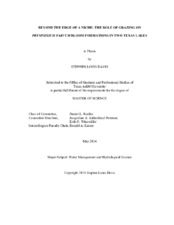| dc.contributor.advisor | Roelke, Daniel | |
| dc.creator | Davis, Stephen Louis | |
| dc.date.accessioned | 2015-01-09T20:25:53Z | |
| dc.date.available | 2015-01-09T20:25:53Z | |
| dc.date.created | 2014-05 | |
| dc.date.issued | 2014-03-25 | |
| dc.date.submitted | May 2014 | |
| dc.identifier.uri | https://hdl.handle.net/1969.1/152589 | |
| dc.description.abstract | Prymnesium parvum (golden algae) is a harmful algal bloom species that has caused tens of millions of dollars in natural resource damages in Texas as a result of massive fish kills. This species is present in many Texas lakes, but does not form blooms in all of them. Previous literature has suggested that predation, specifically by rotifers, may be an important loss factor to P. parvum populations. This research is focused on investigating whether grazing by rotifers is a significant factor in the prevention of blooms in some lakes. Three-day in-lake mesocosm experiments were conducted during times of bloom initiation and bloom development in two Texas lakes (Whitney and Somerville) where the former experiences P. parvum blooms and the latter does not. Controls and treatments consisted of P. parvum cultures in log- and stationary-growth phases, natural phytoplankton assemblages, and natural rotifer assemblages from each lake. Monitored parameters included P. parvum population density and population growth rate, toxicity, chlorophyll-a, and zooplankton biovolume.
Findings reveal that rotifers in Lake Somerville preferentially grazed P. parvum of all growth phases, while experiencing no negative effects from exposure. Some rotifers even exhibited trends of positive effects from exposure. The mesocosm experiments confirmed that rotifer assemblages in Lake Somerville effectively graze P. parvum with no observed negative effects. These findings support the theory that grazing of P. parvum by rotifers is an important contributing factor preventing blooms in Lake Somerville. On the other hand, rotifers from the winter Lake Whitney experiment appeared to preferentially graze P. parvum populations inoculated from log-growth phase culture while significant reductions in rotifer biovolume were observed. P. parvum inoculated from stationary-growth phase culture were not significantly grazed, nor were other phytoplankton within the treatment suggesting that sub-lethal toxic effects from ingestion of stationary phase cells caused a decrease in zooplankton metabolic rates. These lake-specific relationships between P. parvum and rotifers may have been due to microevolutionary adaptation. For example, variation in biovolume responses of rotifers to P. parvum exposure between lakes is a result of rapid microevolutionary adaptation from constant low-level toxin exposure in Lake Somerville as a function of salinity. | en |
| dc.format.mimetype | application/pdf | |
| dc.language.iso | en | |
| dc.subject | Prymnesium parvum | en |
| dc.subject | golden algae | en |
| dc.subject | harmful algal bloom | en |
| dc.title | Beyond the Edge of a Niche: The Role of Grazing on Prymnesium parvum Bloom Formations in Two Texas Lakes | en |
| dc.type | Thesis | en |
| thesis.degree.department | Wildlife and Fisheries Sciences | en |
| thesis.degree.discipline | Water Management and Hydrological Science | en |
| thesis.degree.grantor | Texas A & M University | en |
| thesis.degree.name | Master of Science | en |
| thesis.degree.level | Masters | en |
| dc.contributor.committeeMember | Aitkenhead-Peterson, Jacqui | |
| dc.contributor.committeeMember | Winemiller, Kirk | |
| dc.type.material | text | en |
| dc.date.updated | 2015-01-09T20:25:53Z | |
| local.etdauthor.orcid | 0000-0003-2333-5738 | |


